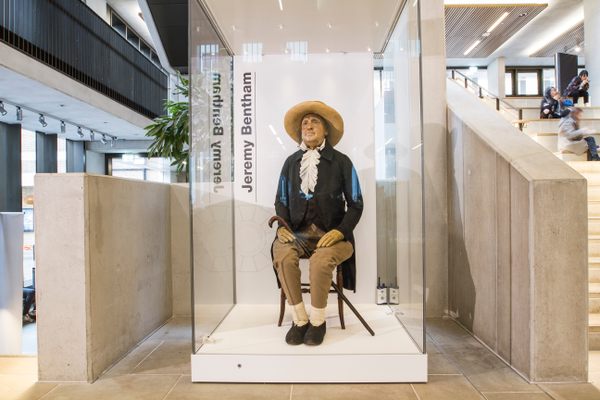100 Wonders: The Head of Jeremy Bentham
Bodies end up being preserved in many ways, for many reasons, and through many different means. Few are as unique as Jeremy Bentham’s preserved head and skeleton, though.
The philosopher had his skeleton de-fleshed, dressed it up in one of his standard black suits, and stuck his mummified head atop it. Brought to life with a pair of bright glass eyes, this was his “auto-icon.”
A more common way bodies end up lasting long after death is through natural mummification, a phenomenon more jauntily referred to as “spontaneous mummification.” These are bodies preserved accidentally by extreme heat, cold, dryness, or in other circumstance where they are in low oxygen environments, such as at the bottom of bogs.
The 2000-year-old Lindow man was discovered at the bottom of a bog with a blow to the head and a rope knotted around his neck—a crime scene perfectly preserved for two millennia. The Maronite mummies of Qadisha Valley were hiding in a cave during a siege when they died. The cool dry environment preserved their bodies for the next 700 years until they were discovered by a team of speleologists. Same with the mummies found in a church basement, and the hundreds of mummies on display in Mexico’s Museo De Las Momia De Guanajuato.
Of course, the most familiar method of mummification is also the most deliberate one. Known as “Anthropogenic Mummification,” this method is exemplified by the mummies of ancient Egypt. But it also covers mummies of a religious nature.
Examples of these range across different faiths. Religious mummies include Buddhism’s mummified monks, like Ivolginsky Datsan and the Sokushinbutsu of Japan, both of whom began mummifying themselves while still living. Catholicism is also chock full of mummified remains. There’s the full body mummy of Catherine of Bologna, and the mummified right fist of a Hungarian Saint King, just for starters.
But Jeremy Bentham’s Auto-Icon stands alone. Bentham preserved his corpse not for religious reasons, but for secular philosophical reasons, and unlike legions of other mummies, he did it of his own plan and accord.
Bentham even wrote an unpublished treatise on the subject titled “Auto-Icon; or, Farther Uses of the Dead to the Living.” In this he described both his reasons for turning himself into well-preserved corpse and his vision of the benefits if everyone did this. He ended this treatise with the final and most important reason for turning himself into an Auto-Icon.
“It would set curiosity in motion, – virtuous curiosity.”

























Follow us on Twitter to get the latest on the world's hidden wonders.
Like us on Facebook to get the latest on the world's hidden wonders.
Follow us on Twitter Like us on Facebook